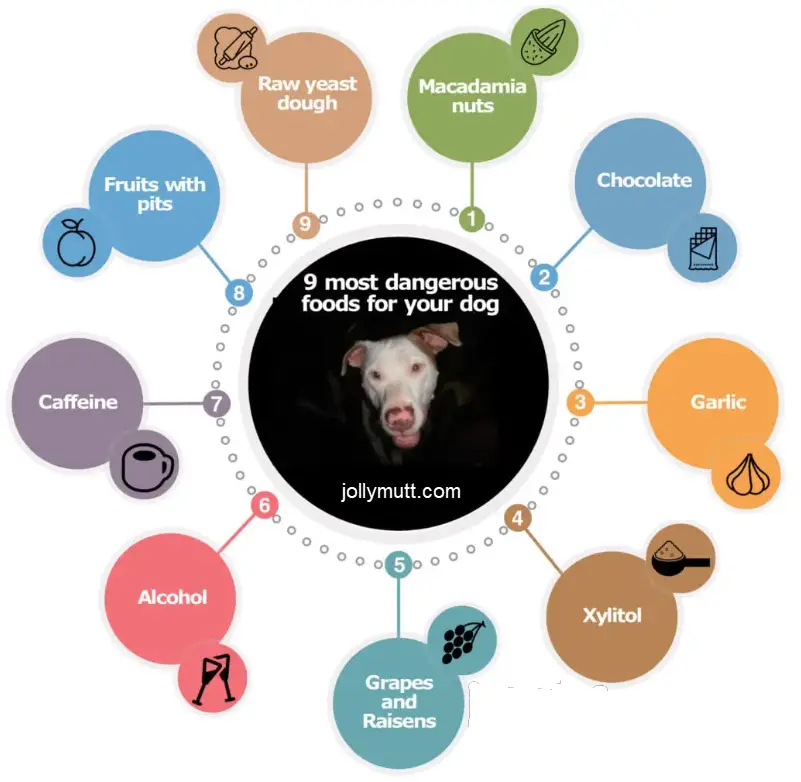ASPCA poison control hotline – available 24/7/365: (888) 426-4435
The 9 most dangerous foods for dogs
Even the most attentive dog owner can’t keep Fido out of trouble all the time. Dogs are curious and persistent and may, despite your best efforts, end up eating the wrong thing. Below is a list of the most dangerous foods for dogs, the symptoms you may see, and the immediate steps to take. We covered what we thought of as the “top 9” but then couldn’t make ourselves stop, so we covered a few others as well.
Note that your dog’s breed, size, and state of health will often determine its reaction to the items below. A tiny dog will need less chocolate, for example, to be in harm’s way than a larger dog. Then again, the danger posed by some items (grapes and caffeine, for instance) seems to be affected less by the size, breed, and health of the dog.
You’ll notice that every ‘treatment’ item below includes a call to your vet. This is not a typo or cut/paste error. Your vet should be your first response in all cases.
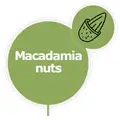 Macadamia nuts are never safe for dogs.
Macadamia nuts are never safe for dogs.
- I placed this at the top as it’s one of the most dangerous things a dog can eat. It doesn’t take much (as little as 2 grams), and the effects can be fatal.
- Combined with chocolate (see below), it’s about as bad as it can get.
- Interestingly, dogs are the only species reported to have this problem with macadamia nuts so far. Also, we do not know what causes the toxicity, and there is no specific antidote.
- Symptoms: Often, the first symptom is weakness in the back legs, vomiting, shaking, and diarrhea. These symptoms can occur as long as 3 days after ingesting but normally within 12 hours.
- Treatment: Call your vet quickly. IVs, pain relief, and even oxygen to help with respiratory distress may be required.
 Chocolate is dangerous for dogs and the darker the chocolate, the more dangerous it is.
Chocolate is dangerous for dogs and the darker the chocolate, the more dangerous it is.
- The theobromine in chocolate can be deadly for dogs and in surprisingly small doses.
- The darker the chocolate, the more dangerous it is. Count cocoa powder and baker’s chocolate at the very top of the most dangerous list
- Even white chocolate contains theobromine, so there is no “safe” chocolate.
- Chocolate-covered macadamia nuts? Keep ’em far away from dogs!
- Symptoms: It may take up to 12 hours. Extreme thirst, diarrhea, hyperactivity, panting, shaking, and seizures.
- Treatment: Call your vet quickly, and induce vomiting if the dog hasn’t already vomited, and it’s been less than one hour.
- A viable dog-safe chocolate alternative is Carob. Healthy and safe for your pups but, as with all treats, share with them in moderation.
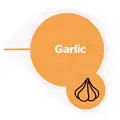 Garlic and onions should not be fed to dogs
Garlic and onions should not be fed to dogs
- Really, anything in the allium family. This goes for raw, of course, but also powdered, baked, and cooked as well. There is no place in any dog’s diet for even a small amount of garlic or onions.
- Symptoms: Lethargy, hyper-salivation, vomiting, diarrhea, pale gums, unconsciousness
- Treatment: Call your vet quickly. Most likely, a visit will be necessary to keep him comfortable. In extreme cases, IVs and even blood transfusions could be needed.
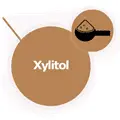 Xylitol is the only listed artificial sweetener that is dangerous to dogs
Xylitol is the only listed artificial sweetener that is dangerous to dogs
- Many diet foods contain Xylitol, which can cause your dog’s blood pressure to drop dangerously. It can also cause liver failure. Personally, I’m on a lifelong Keto plan and use Xylitol just about every day. I’m always super cautious about anything I make and the ingredients I use.
- It’s worth noting that studies have found that Xylitol may well belong at the very top of this list of dangerous foods for dogs.
- Xylitol is found in many foods you may not expect, such as peanut butter and candy, so be a label reader. You will also see Xylitol in many “sugar-free” offerings, even medication so be on the alert.
- There are no other artificial sweeteners that have this effect. To date, the Veterinary Poisons Information Service highlights Xylitol as the only one to be aware of.
- Symptoms: Vomiting, weakness, lethargy, tremors, seizure, coma
- Treatment: Call your vet quickly. Do not induce vomiting unless specifically directed to by your vet.
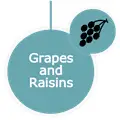 Grapes and raisins should never be fed to dogs
Grapes and raisins should never be fed to dogs
- It only takes a small amount to cause kidney damage very quickly or even death.
- After studying this for over 20 years with no understanding of why grapes and raisins are so dangerous for dogs, The ASPCA Poison Control Center has recently released its findings where they conclude that the Tartaric Acid in grapes and raisins is the culprit.
- It’s important to note that neither peeled grapes nor seedless grapes are safe for dogs.
- This includes grape juice and things like trail mix that has raisins.
- This is an odd case because the size, breed, and overall health of the dog are not factors as to if they will be affected or how badly they are affected.
- Because of how common these are and their serious nature, and how quickly they can impact the dog, we consider this one of the most dangerous foods.
- Symptoms: Shock, difficulty breathing, coma, death.
- Treatment: Call your vet quickly. If eaten within the last two hours, induce vomiting unless your dog has already vomited. Rush to the vet – this is critical.
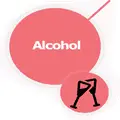 Alcohol affects dogs far faster than it does humans and should never be given to dogs
Alcohol affects dogs far faster than it does humans and should never be given to dogs
- Yeah, they shouldn’t be sharing your beer. Lord knows I’ve shared a few with my pups, but that was in the days before I knew better. These days, it doesn’t happen.
- It has the same effect on dogs as it does on humans but requires far less. The smaller the dog, the less it requires to be dangerous. Alcohol should never be given to dogs.
- Symptoms: Vomiting, reduced coordination, difficulty breathing, coma, and even death.
- Treatment: Call your vet. If it’s a small amount, it’s probably OK, but are you willing to take that chance? If a large amount, a vet visit is urgently needed. Call them when you’re on the way so they’ll be ready.
 Caffeine, even in small to moderate amounts, is dangerous for dogs
Caffeine, even in small to moderate amounts, is dangerous for dogs
- No coffee, soda, or tea. A moderate amount can be enough to kill smaller dogs while making larger dogs very sick.
- This includes coffee grounds (so be careful where you dump them), coffee beans, energy drinks, etc.
- Symptoms: Vomiting, panting, shaking, hyperactivity, tremors, seizures, and death.
- Treatment: Call your vet quickly. May need to induce vomiting.
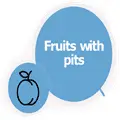 Fruits with pits may cause blockage and can contain arsenic
Fruits with pits may cause blockage and can contain arsenic
- This includes peaches, prunes/plums, olives (yes, they are fruits!), etc. First, the pits can cause a blockage, which is painful and can be fatal. Second, some pits contain arsenic, which, of course, can be fatal.
- Symptoms: Belly pain, lethargy
- Treatment: Call your vet for advice. It may be a “wait and see” thing, but a trip to the vet will most likely be required if there is a blockage.
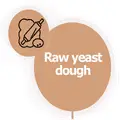 Raw yeast dough will expand in your dog’s stomach and also will create alcohol
Raw yeast dough will expand in your dog’s stomach and also will create alcohol
- If you’re making bread and think it’s OK to toss Fido a chunk of dough, please re-think that. The dough can and will expand, causing pain and discomfort. And, as the yeast metabolizes, alcohol is formed, which can cause further harm.
- Symptoms: Bloating, belly pain. May also see the same symptoms as alcohol (above), including loss of coordination, vomiting, and difficulty breathing.
- Treatment: Call your vet quickly.
Those are the top 9 most dangerous foods for dogs in our book – the ones to really keep an eye out for, and that can cause damage very quickly.
One thing to note about these or any other harmful foods is that if you’ve been giving your dogs any of these as treats, that doesn’t make it OK. Just because your dog hasn’t had a problem with them yet doesn’t mean it won’t happen. There are plenty of good, healthy treats available, so rather than using olives as a treat during training, find a good, healthy, low-fat alternative.
Other harmful foods for dogs to consider
These don’t make our “top 9” of the most dangerous foods for dogs, but that doesn’t mean they should be taken lightly. These can be life-threatening as well.
Apple Seeds
- The shell of apple seeds contains a small amount of cyanide, so eating these in large amounts is bad for your dog (or anything, really). And, it’s important to note, when I say large amounts, I mean LARGE amounts. If your dog is eating entire apples all day, you may have cause to be concerned. Then again, there will be other side effects from that long before eating enough to be affected by the cyanide.
- It’s important to note that this can build up over time. So if your dog is eating apple seeds over a prolonged period, this can be problematic.
- Symptoms: Digestive blockage – eating that many apples and seeds will usually manifest in this way long before cyanide poisoning is a concern
- Treatment: Call your vet.
Hops
- Yep, your favorite beer ingredient, so if you homebrew, know that those hops can be quite harmful to dogs. Ingesting hops can cause hops toxicity, where your dog’s body temperature may rise to life-threatening levels. The exact amounts to cause harm are not known.
- This includes hops in any form, whether used or unused so take care of how and where you dispose of them.
- Some breeds are more susceptible to hop poisoning: Saint Bernards, Dobermans, English springer spaniels, Border collies, Greyhounds, and Retrievers.
- Symptoms: Quickly increasing body temperature, excessive panting, abdominal pain, increased heart rate.
- Treatment: Call your vet, and cool the dog off in any way possible. Induce vomiting (unless the vet says otherwise) if ingested within one hour.
Moldy foods
- Many molds produce mycotoxins that can have severe effects on dogs. Your compost pile may contain as many as 20 different molds that fall into this category if you compost.
- Moldy foods are unappetizing for humans, but dogs will find them to be a treat. Take great care of where your composting takes place.
- Symptoms: Vomiting, diarrhea, tremors, seizures, elevated body temperature
- Treatment: Call your vet quickly, as this is one that can get bad fast. Keep the dog cooled and hydrated.
Licorice
- In large amounts, candy licorice can cause adrenal gland issues as well as muscle damage for your dog. Glycyrrhizin is the culprit here, and too much of it can cause decreased blood pressure and decreased potassium levels, and for dogs on blood thinners can also increase the risk of bleeding.
- Note that many vets prescribe herbal form licorice pills or powder to treat gastrointestinal issues and skin allergies. In these cases, de-glycyrrhizined licorice is used.
- Also, sugar. Licorice is candy, and we should never feed our dogs as candy.
- Symptoms: Vomiting, diarrhea, lethargy
- Treatment: Call your vet
Avocado
- Avocados contain “persin”, a substance found in the bark, leaves, pits, and meat of avocados and can be toxic for dogs in high doses. As the avocado ripens, the persin is lessened.
- In actuality, the main danger here is if you have avocado plants or just a lot of avocados lying around. The fruit itself is high fat, the pits can cause choking, and eating in excess may result in vomiting, diarrhea, and myocardial damage due to the persin.
- Symptoms: Vomiting, diarrhea, abdominal discomfort.
- Treatment: This is worth a call to the vet if many avocados were eaten, or perhaps Fido was chewing on the tree.
Milk and other dairy products
- This means ice cream! Dairy products can cause diarrhea and also trigger other food allergies. Also, dogs can be lactose intolerant, so proceed at your own risk.
- Symptoms: Vomiting, diarrhea, tummy pain
- Treatment: This is a case where your dog will probably be fine but always call your vet to be sure.
What else?
The normal stuff that’s not good for us humans is often not good for our four-legged friends and usually for about the same reason.
- Salt – too much salt is bad for anything.
- Sugar – there’s no upside for humans or dogs eating sugar. Also, as mentioned above, artificial sugar such as Xylitol is dangerous for dogs.
- Raw eggs – the danger of salmonella or E Coli poisoning
- Human medicine – treat your dogs like your kids here. That’s what they are—small, four-legged furry kids.
- Human vitamins – The multivitamins we take containing “100% of the recommended RDA of this-or-that” are way over the recommended RDA for dogs. Giving a dog multivitamins can quickly cause a mineral overdose. Prenatal vitamins are the worst – the amount of iron in a prenatal vitamin is dangerous to dogs.
- Potato chips – because, well, they’re not good for anybody or anything. And salt. Too much salt.
- Antifreeze – I know, it’s not a food, but it’s important to mention. If you have a car leaking radiator fluid, or if you’ve managed to spill some, do not let your dog drink it. They find it tasty and will quickly lap it up if allowed. This can be fatal in small amounts. About 5 tablespoons can kill a medium-sized dog.
For more information about what your dog should and should not eat, be sure to take a look at our “Can dogs eat…” article where we cover over 80 different items.
What do you do if your dog eats dangerous food?
The first step is always avoidance. Ensure these dangerous foods are not readily available to your dog. Certainly, don’t feed them as treats.
But if the time comes when treatment is required, an emergency call to your vet is always the best first step. You should have the number of your vet and after-hours emergency vet on speed dial and hang it from your refrigerator on a magnet for easy access. Right?
The ASPCA has a poison control hotline available 24/7/365 – please make a note of it: (888) 426-4435
The Pet Poison Helpline has been helping pet owners for over 15 years. Their number is 855-764-7661. Note that there is currently a $59 fee that is charged when you call. Follow on consultations are included in that. Trust me, in an emergency, the $59 is money well spent, and you will be speaking with an expert.
Should I wait to see what happens?
It hurts my feelings a bit that folks ask this, but ask it they do. So I feel compelled to mention it.
No, don’t wait.
Your dog’s life could be in danger.
At the very least, call your vet or your local emergency vet. Or the ASPCA number listed above.
In the end, you may be told to wait, but at least you’ll be hearing that from an expert that has seen this a thousand times and knows what to look for.
Should you always induce vomiting?
No, you should not. This is dependent on what your dog has ingested and when. The best advice is to consult your veterinarian or one of the emergency numbers above. When dealing with toxins or dangerous foods, vomiting is usually the best course if done within the first hour, maybe up to four hours.
If your dog has induced a potentially caustic chemical, inducing vomiting will bring that caustic material back into the throat and potentially cause more harm than good.
If your dog has ingested a petroleum-based product, that could potentially be aspirated into the lungs during vomiting.
So it’s not an automatic “I have to make him vomit” situation.
How to induce vomiting
Inducing vomiting is not always recommended, but in cases where it is, a quick method is to use one tablespoon of hydrogen peroxide for every 20 pounds of your dog’s body weight. Put this into a turkey baster or small syringe and shoot it into his throat. Often you’ll need to keep their mouth closed and maybe rub their throat. If they don’t vomit within 15 minutes, give one more dose. Do not give a third.
After they vomit, don’t give them any food or water.
If it has been more than 4 hours since your dog ate the offending item, vomiting may be less helpful as the food will have moved into the small intestine. Vomiting is most successful within the first hour.
Other points about inducing vomiting:
- If the dog has already vomited, it is not helpful to induce vomiting again.
- If the dog is having a seizure or has had one recently, inducing vomiting can cause another seizure.
- Do not induce vomiting on a dog that is unresponsive or unconscious.
Wrapping it all up
As mentioned, we can’t always keep up with where Fido puts his nose so accidents will happen. The key is being prepared. Make sure you have the vet’s number and the after-hour emergency vet’s number handy.
Err on the side of caution and call the vet even if you think everything will be fine.
The best approach is to prevent the problem from happening, so be careful where you store those macadamia nuts, fence off that compost pile, and don’t share your Scotch with your four-legged friend.
None of the items on the list above are acceptable treats or rewards, so please don’t consider them even if you’ve shared them with your dog in the past. Tossing a tasty chocolate kiss for your dog doing his favorite trick is asking for trouble. You owe it to your dog to find a healthy alternative.
Unfortunately, the most dangerous foods for dogs are often some of the most common items we have lying around and readily available, so understanding the inherent danger and a careful approach is needed.
We often hear “can dogs eat [fill in the blank]” so we are working on a series of articles to discuss these topics. Please see our additional articles on our main dog health page.
Also for a more informative overview about what your dog should and should not eat, be sure to take a look at our “Can dogs eat…” article where we cover over 80 different items.

